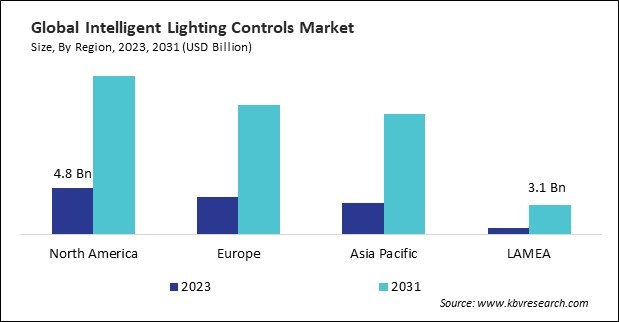According to a new report, published by KBV research, The Global Intelligent Lighting Controls Market size is expected to reach $45.7 billion by 2031, rising at a market growth of 17.6% CAGR during the forecast period.
Intelligent lighting controls are advanced systems designed to optimize lighting efficiency, enhance user experience, and integrate seamlessly with other smart building technologies. Unlike traditional lighting systems, which are often static and manually operated, intelligent lighting controls use a combination of sensors, control interfaces, and software to automatically adjust lighting based on occupancy, daylight availability, and user preferences. These systems offer many benefits, including energy savings, improved comfort, and increased flexibility.

The Wired segment is registering a CAGR of 17.2 % during the forecast period. Wired systems are generally perceived to be more reliable and stable than wireless alternatives. In applications where uninterrupted operation is crucial, such as in commercial buildings or industrial settings, wired solutions are preferred due to their consistent performance.
The Sensors segment led the Global Intelligent Lighting Controls Market by Type in 2023; thereby, achieving a market value of $11.3 billion by 2031. Sensors are crucial in automating lighting systems based on environmental conditions such as occupancy, daylight levels, and motion detection. This automation saves energy by ensuring lights are only on when needed.
The Smart Cities segment is growing at a CAGR of 16.7 % during the forecast period. Intelligent lighting systems achieve substantial energy savings through sensor-driven occupancy detection that adjusts lighting levels accordingly. This helps cities achieve their energy efficiency goals and reduce overall operational costs.
Full Report: https://www.kbvresearch.com/intelligent-lighting-controls-market/
The North America region dominated the Global Intelligent Lighting Controls Market by Region in 2023, and would continue to be a dominant market till 2031; thereby, achieving a market value of $16.5 billion by 2031. The Europe region is anticipated to grow at a CAGR of 17.2% during (2024 - 2031). Additionally, The Asia Pacific region would witness a CAGR of 18.5% during (2024 - 2031).
By Connectivity Type
By Type
By Application
 Unique Offerings
Unique Offerings